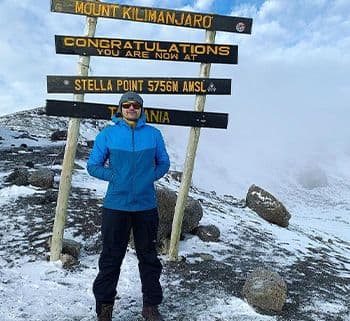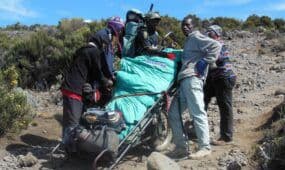
Climbing Mount Kilimanjaro: Understanding Altitude Sickness
May 3, 2024
Ben
Climbing Mount Kilimanjaro is an exhilarating and rewarding adventure, but it's essential to be prepared for the challenges that come with high altitude
Certainly, here's a descriptive list of altitude sicknesses commonly encountered during climbs up Mount Kilimanjaro:

- Acute Mountain Sickness (AMS): AMS is the most common form of altitude sickness, characterized by symptoms such as headaches, nausea, dizziness, fatigue, and difficulty sleeping. It typically occurs at altitudes above 2,500 meters (8,200 feet).
- High Altitude Cerebral Edema (HACE): HACE is a severe and life-threatening form of altitude sickness that occurs when fluid accumulates in the brain due to prolonged exposure to high altitudes. Symptoms may include severe headaches, confusion, hallucinations, loss of coordination, and altered mental status.
- High Altitude Pulmonary Edema (HAPE): HAPE is another potentially fatal condition caused by fluid buildup in the lungs at high altitudes. Symptoms include breathlessness, coughing, frothy or pinkish sputum, chest tightness, and blue or gray lips or fingernails.
- Altitude-induced Dehydration: Dehydration can occur at high altitudes due to increased respiratory rate, sweating, and decreased fluid intake. Symptoms may include dry mouth, thirst, dark-colored urine, and fatigue.
- Altitude-induced Hypothermia: Hypothermia can occur when climbers are exposed to cold temperatures at high altitudes, especially during rest breaks or overnight stays. Symptoms include shivering, confusion, slurred speech, clumsiness, and drowsiness.
- Altitude-induced Sunburn: Sunburn can be more severe at high altitudes due to increased ultraviolet (UV) radiation exposure. Symptoms include redness, pain, swelling, and blistering of the skin.
- Altitude-induced Fatigue: Climbers may experience extreme fatigue at high altitudes due to decreased oxygen levels and physical exertion. Symptoms include weakness, lethargy, and difficulty concentrating.
- Altitude-induced Insomnia: Difficulty sleeping is common at high altitudes due to changes in oxygen levels and environmental factors. Insomnia can exacerbate other altitude sickness symptoms and impact overall well-being.
Awareness of these altitude sicknesses and their symptoms is crucial for climbers ascending Mount Kilimanjaro, enabling them to recognize warning signs early and take appropriate measures to ensure a safe and successful expedition.
Certainly, here's a descriptive list of altitude sicknesses commonly encountered during climbs up Mount Kilimanjaro:
- Acute Mountain Sickness (AMS): AMS is the most common form of altitude sickness, characterized by symptoms such as headaches, nausea, dizziness, fatigue, and difficulty sleeping. It typically occurs at altitudes above 2,500 meters (8,200 feet).
- High Altitude Cerebral Edema (HACE): HACE is a severe and life-threatening form of altitude sickness that occurs when fluid accumulates in the brain due to prolonged exposure to high altitudes. Symptoms may include severe headaches, confusion, hallucinations, loss of coordination, and altered mental status.
- High Altitude Pulmonary Edema (HAPE): HAPE is another potentially fatal condition caused by fluid buildup in the lungs at high altitudes. Symptoms include breathlessness, coughing, frothy or pinkish sputum, chest tightness, and blue or gray lips or fingernails.
- Altitude-induced Dehydration: Dehydration can occur at high altitudes due to increased respiratory rate, sweating, and decreased fluid intake. Symptoms may include dry mouth, thirst, dark-colored urine, and fatigue.
- Altitude-induced Hypothermia: Hypothermia can occur when climbers are exposed to cold temperatures at high altitudes, especially during rest breaks or overnight stays. Symptoms include shivering, confusion, slurred speech, clumsiness, and drowsiness.
- Altitude-induced Sunburn: Sunburn can be more severe at high altitudes due to increased ultraviolet (UV) radiation exposure. Symptoms include redness, pain, swelling, and blistering of the skin.
- Altitude-induced Fatigue: Climbers may experience extreme fatigue at high altitudes due to decreased oxygen levels and physical exertion. Symptoms include weakness, lethargy, and difficulty concentrating.
- Altitude-induced Insomnia: Difficulty sleeping is common at high altitudes due to changes in oxygen levels and environmental factors. Insomnia can exacerbate other altitude sickness symptoms and impact overall well-being.

Embarking on a journey to conquer Mount Kilimanjaro promises a blend of exhilaration and challenge, with altitude sickness looming as a formidable adversary along the ascent. As climbers ascend Africa's highest peak, understanding the intricacies of altitude sickness and mastering strategies to prevent and manage its symptoms becomes paramount for a safe and gratifying expedition. Below, we present essential tips and insights tailored to climbers grappling with altitude-related afflictions on their Mount Kilimanjaro odyssey:
- Gradual Acclimatization: Opt for a trekking route that facilitates gradual acclimatization, allowing the body to adjust to the diminishing oxygen levels encountered at higher altitudes. Rushing the ascent heightens susceptibility to altitude-related ailments.
- Hydration Vigilance: Maintaining optimal hydration levels is imperative amidst the elevated altitudes of Mount Kilimanjaro. Consistently replenish fluids, irrespective of thirst cues, while abstaining from alcohol and caffeine consumption, which can exacerbate dehydration.
- Nutritional Fortitude: Sustain yourself with a well-rounded diet replete with carbohydrates and proteins, furnishing the requisite energy reserves for the demanding climb. Adequate nutrition bolsters immunity and overall well-being, mitigating the risk of altitude sickness.
- Symptom Awareness: Familiarize yourself with the gamut of altitude sickness symptoms, spanning from throbbing headaches and queasiness to lightheadedness, weariness, and disrupted sleep patterns. Prompt recognition of these indicators is pivotal for timely intervention.
- Attune to Bodily Cues: Cultivate a keen sensitivity to bodily signals throughout the expedition. Should symptoms of altitude sickness manifest, refrain from persevering through discomfort. Descend to lower altitudes as needed and prioritize rest until equilibrium is restored. Neglecting symptoms can precipitate more severe manifestations like high altitude cerebral edema (HACE) or pulmonary edema (HAPE).
- Pharmaceutical Precaution: Consider carrying medication such as acetazolamide (commonly known as Diamox) to preempt altitude sickness. Consult with a medical professional prior to departure to ascertain the appropriate dosage and potential side effects.
- Thermal Comfort and Repose: Optimal rest and thermal insulation are indispensable for fostering altitude adaptation. Equip yourself with suitable attire to withstand the chilly nocturnal temperatures at higher elevations, and accord due emphasis to recuperative downtime.
- Open Dialogue with Guides: Forge a transparent line of communication with your expedition guide. Confide any apprehensions or symptoms you encounter, availing yourself of their expertise and support throughout the journey.
- Decisive Descent Protocol: In instances where symptoms persist unabated or escalate despite remedial measures, descending to lower altitudes becomes imperative. Waste no time in executing this recourse and seek medical assistance if warranted.
- Mental Preparedness: Conquering Mount Kilimanjaro is as much a test of mental fortitude as physical prowess. Maintain a positive outlook, stay resolute, and relish the unfolding spectacle. With meticulous preparation and mindfulness, the challenges posed by altitude sickness can be surmounted, ushering climbers towards the pinnacle of triumph.
Embracing these recommendations equips climbers with the armor necessary to navigate the intricacies of altitude sickness, fostering a safer and more fulfilling expedition up the hallowed slopes of Mount Kilimanjaro. Prioritize safety, heed the body's signals, and bask in the splendor of Tanzania's iconic summit.

